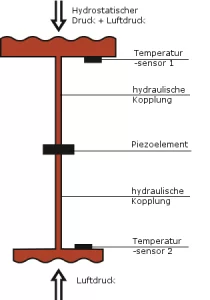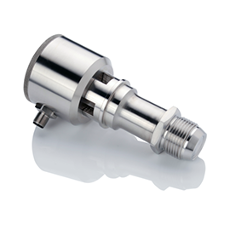Product Finder
Hydrostatic level detection
Operating Principle of the Hydrostatic level measurement
The pressure sensor uses internally a piezo-electric transducer which converts the mechanical process pressure into a proportional voltage signal. This signal is digitally communicated to the sensor head where the signal is converted to industry standard 4...20mA and Hart 7.0 signals. By means of integrated temperature elements in the process cell the electronic device can compensate alternating process temperatures.
Challenge: Humid and cold environmentsEspecially in humid surroundings or in outdoor applications the hydrostatic measuring principle can lead to value drifts or unstable measurements caused by condensate formation. Analysis shows that such failures are mostly caused by the set-up of the measuring technology. In case of hydrostatic detection, the pressure sensor located at the lowest position of the tank measures the pressure of the static head of liquids caused by the liquid column and in addition the momentary surrounding pressure. Both parameters must be considered in order to display the correct content level. In so-called relative pressure sensors cells a thin sleeve leads the atmospheric pressure of the surroundings to the measuring membrane. As the air pressure is now equivalent on both sides of the membrane, the resulting measuring signal is only the existing hydrostatic pressure of the medium in the vessel. Sensors using a diffusion permeable double membrane as a humidity barrier feature one fundamental disadvantage: the diffusion of vapor can’t be avoided permanently. As a consequence, condensing vapor can lead to sensor drift resp. to fluctuating measurements. |

|
Alternative State-of-the-art measuring methodIn opposition to conventional measuring method the Anderson-Negele level sensor LAR-361 is equipped with a hermetically weld-sealed sensor technology. The infiltration of gas or humidity is impossible.The major difference to hydrostatic sensors with diffusion-permeable membranes is that here the atmospheric pressure is detected by a second measuring cell in the sensor. This one is connected hydraulically with the membrane in the process pressure measuring cell, which is in contact with the medium to be measured (e.g. milk). In wet and cold installation environments both inside or outside a building, where conventional sensors have a limited range of application and have a limited life expectancy, this type of sensors presents a reliable and trouble-free alternative. Application examples for hydrostatic level sensors
|

|
The hydrostatic level measurement by means of a pressure transmitter is a well-established measuring method and finds multiple application in the food industry such as dairy plants.

Copyright © 2022 Anderson-Negele